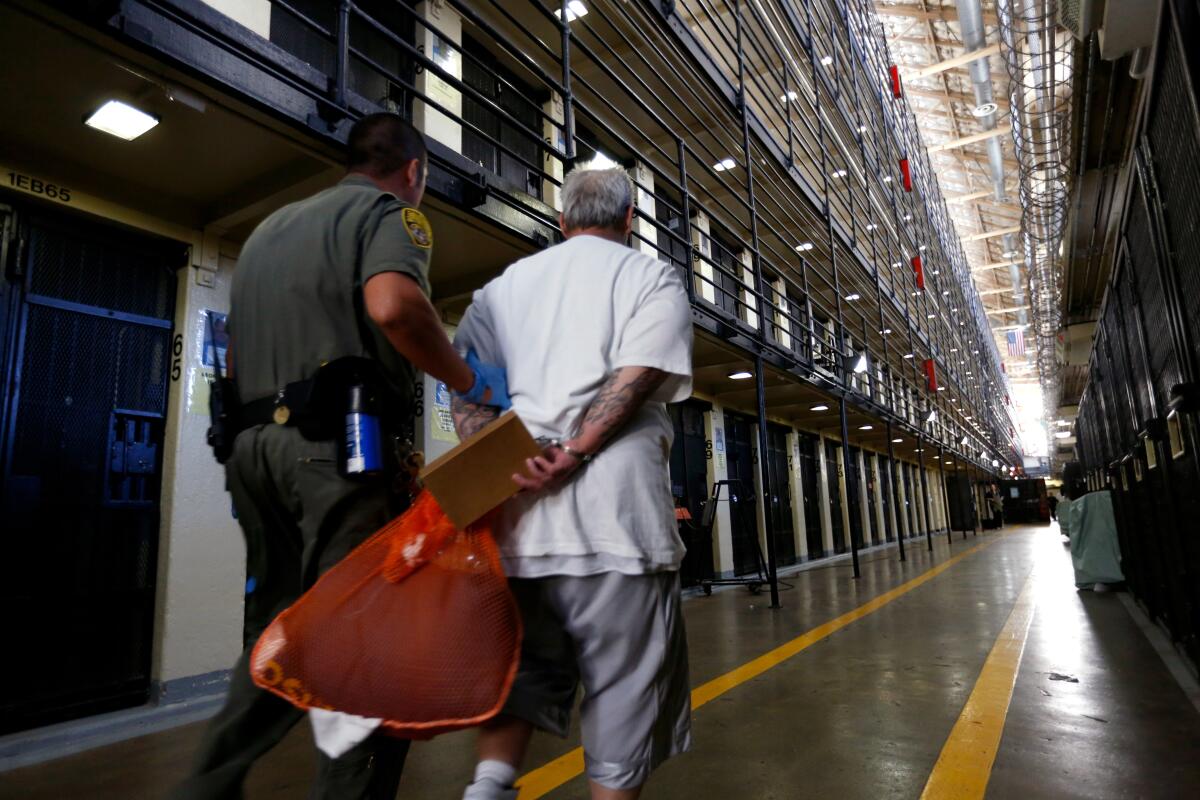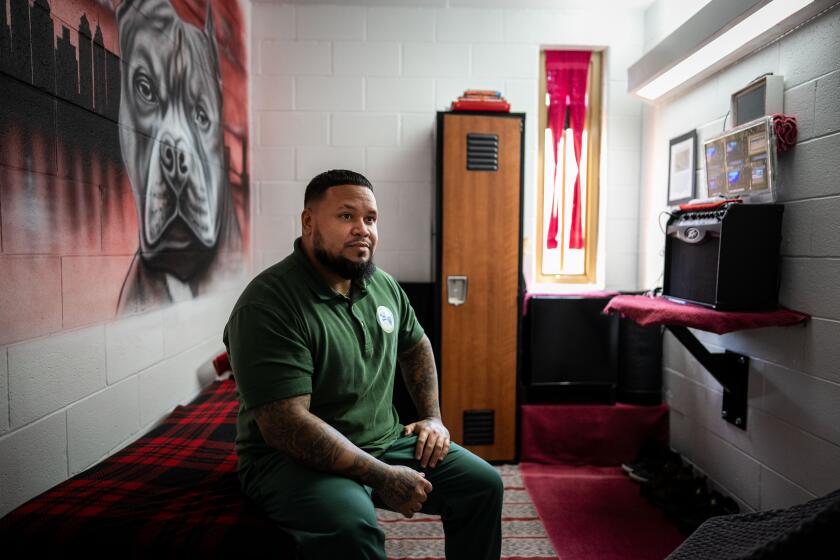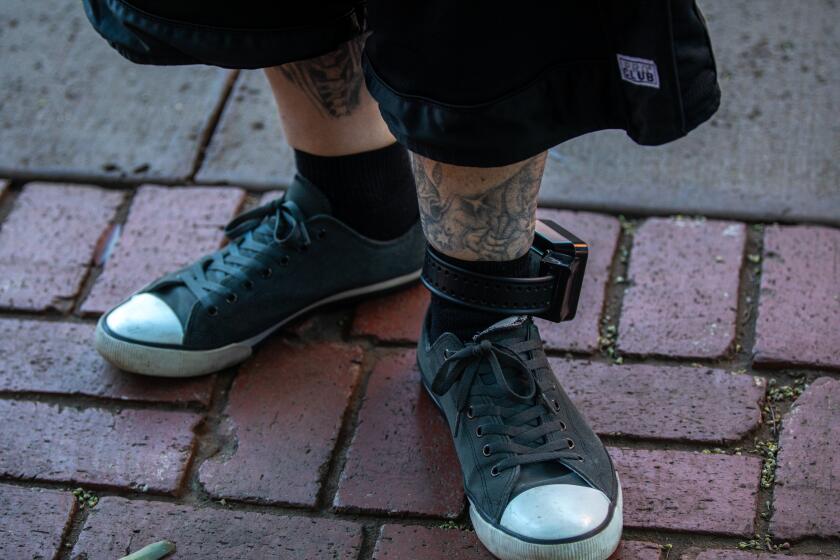Column: Tinkering with Prop. 47 won’t lower crime. Fixing San Quentin will

- Share via
In 2020, after the tragic murder of George Floyd, there was a moment when it seemed as if America, California included, was ready to reform our broken and discriminatory criminal justice system.
In 2024, as the California Legislature returns from vacation, criminal justice is once again at the forefront. But now, the proverbial pendulum has swung and a new tough-on-crime era seems to be creeping up through the cracks of our good intentions.
Proposition 47, which helped lower California’s prison population by changing certain nonviolent crimes from felonies to misdemeanors, is likely to be rolled back, if not undone this year.
The California Highway Patrol has been called in to stop retail theft, despite the fact that no one is entirely sure just how big a problem it is.
Drug dealers are being charged with murder as deaths from fentanyl overdoses continue to spike, a new tactic in a new war on drugs, little different from the one that led to overincarceration of Black and brown people during the crack epidemic of the ’80s when we insisted we could arrest our way out of poverty and addiction.
It is a troubling reversal of both attitude and reform that, as history has proven, will not lead to the safer communities we all want.
But what is about to happen inside San Quentin State Prison has the potential to fundamentally change crime and punishment in the Golden State, and beyond.
Because as much as we want to believe that a single law, more police or a tougher sentence can protect us, the truth is that the best way to cut crime is to stop it from happening in the first place — not with the pounding fist of punishment that for decades has left us with jails and prisons where more than a third of people return within a few years of release.
But instead by helping people to find other paths, and giving them opportunities to survive in ways that uplift rather than prey upon our communities — an approach with proven results both in the U.S. and other countries, where incarceration decades ago embraced rehabilitation not as an option but a mandate.
Gov. Gavin Newsom this week will announce plans to remake San Quentin, one of the state’s most storied prisons, using a Scandinavian prison model that emphasizes rehabilitation.
Last year, Gov. Gavin Newsom announced that he wanted to transform San Quentin, California’s oldest and most famous prison, into a new kind of incarceration facility modeled after Scandinavian principles of rehabilitation, where that mandate for changing lives is written into law.
With his love of catchphrases, he dubbed it the California Model and left the details for later. On Friday, a long-awaited explanation of what the California Model will look like in practice was released, providing both an ideal and a blueprint for what is a radical, subversive and important shift in what it means to be in prison.
“This is a big deal,” Darrell Steinberg told me. He helped chair the committee that created the recommendations, and is the mayor of Sacramento, a city as plagued as any by the drug addiction, mental illness and homelessness that have driven much of the shift in attitudes around crime. So he knows as well as any that voters want results, not experiments.
“This will enhance public safety for the self-evident reason that when people have the tools to succeed on the outside they will have better lives and are much less likely to commit another crime,” he said.
It is visionary, he said, but also doable.
A core part of the transition involves changing the job of correctional officers from enforcers and adversaries to participants in rehabilitation, a metamorphosis that the union representing correctional officers supports. Under the plan, officers would take college-level classes on trauma-informed practices, and be expected to interact with inmates as mentors and guides.
Gov. Gavin Newsom wants to change how incarceration is done in the Golden State, using concepts pioneered in Scandinavia. California prison guards visited Norway to see what it would mean.
San Quentin itself would also receive a makeover, albeit one curtailed by our current economic realities. Cramped cells that currently house two people in 46 square feet, about half the size of a decent bathroom, would be removed to allow for single-occupancy spaces that Steinberg said are the minimum dignity demands.
Correctional officers would also see an upgrade. Housing prices are so high in Marin County, where San Quentin is located, that it is impossible for many to live close enough for a daily shift (a two-bedroom averages more than $3,000 a month), leaving them with hours-long commutes.
So some officers have resorted to “dry camping” in trailers with homeless-like conditions that lack running water, electricity or even sewers. They are packing a week’s worth of work into a few days just to get by. The new plan would give correctional officers a campground with basic facilities and access to showers and safe spaces to relax — perhaps making the job less stressful.
For incarcerated people, the change will mean that on Day 1 of their sentences, there is a coordinated effort to arrange services — mental health care, education, job training, substance abuse treatment. And that there are people to implement those plans, and support them.
While that seems basic, it doesn’t happen now. People are largely left to their own devices to navigate an opaque and inefficient system that is so archaic that some of it isn’t even computerized. Wait lists are long and information can be hard to come by.
If the ideas laid out in the plan makes it through the upcoming budget negotiations (in a year with a large and unexpected deficit), it will be a culture change inside the most infamous prison in the country’s second-largest state prison system (Texas is the only state with a larger incarcerated population).
California plans to remake San Quentin as a new kind of prison, modeled after Scandinavian ideals that value rehabilitation over punishment. An L.A. re-entry facility has already made the change.
Though taking the California Model from paper to practice is the work of years, the proposal for San Quentin has the potential to be the largest and most meaningful criminal justice reform in decades — if we get it right, which of course is always an if when it comes to government.
But it is a big swing with the potential for real payoff — not the knee-jerk anger and fear of proposals like gutting Proposition 47, which will only repeat the mistakes of the past.
There will always be predators and there will always be crime. And admittedly, it all sounds touchy-feely and nebulous, like we are about to spend a bunch on money on holding criminals’ hands while they talk about their childhoods and get their GED.
And to be honest, that’s part of it, one we shouldn’t ignore.
At its root, the California Model is about dignity and compassion, creating policy around the belief that healing isn’t just for the innocent, and it isn’t soft.
Fixing humans, especially ones broken enough to hurt others, is the hardest of tasks.
But it can be done.
And if California turns San Quentin into a place where that happens, we will all be safer.
More to Read
Sign up for Essential California
The most important California stories and recommendations in your inbox every morning.
You may occasionally receive promotional content from the Los Angeles Times.














